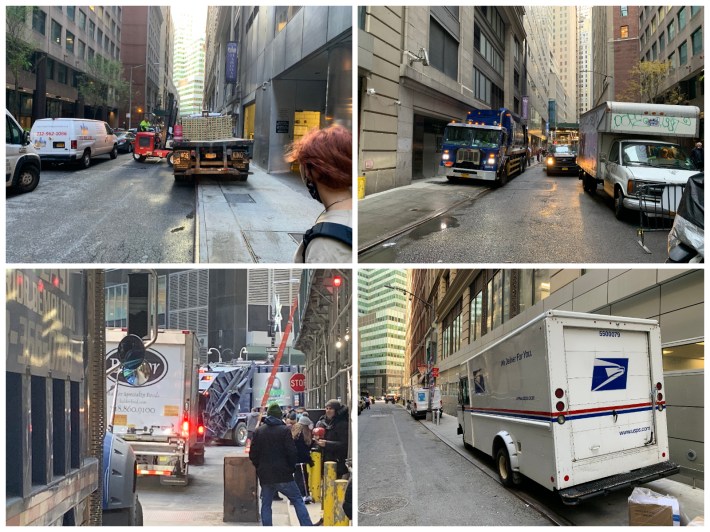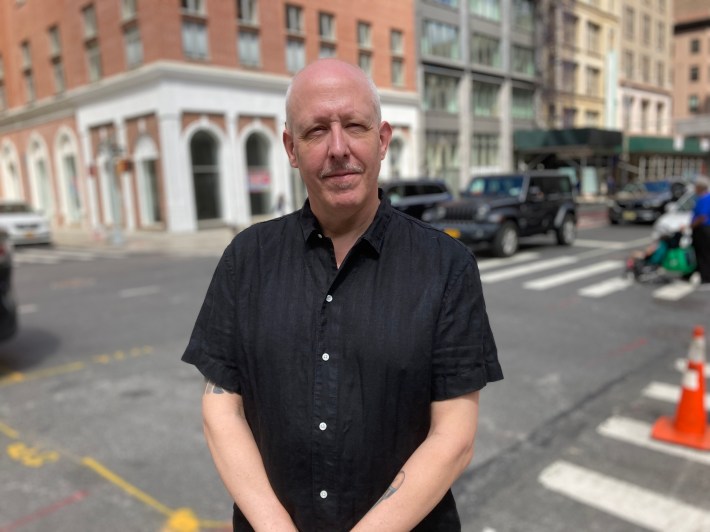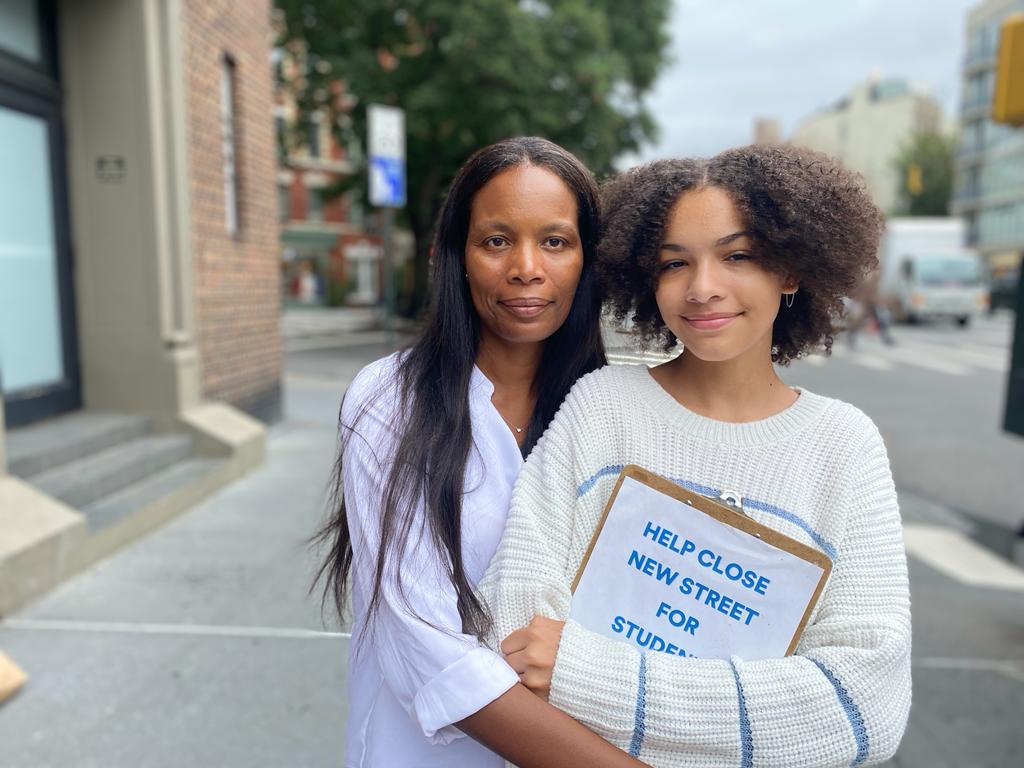Parents at the Lower Manhattan Community Middle School did everything right.
They exhaustively documented the dangers their children face on the street outside their Financial District school, where rampant illegal parking on sidewalks forces kids to walk in the street amid a parade of construction vehicles and delivery trucks.
They obtained hundreds of signatures on petitions calling for the city to restrict traffic on the street during school days to keep kids safe.
They won support for their proposal from their local city Council member and community board.
And yet, more than eight months since the school applied for the Department of Transportation open streets program, the application remains in bureaucratic limbo, with DOT neither approving nor denying it, despite the department's oft-touted commitment to improving street safety around schools.
“We are in ongoing discussions with the school, NYPD, and other stakeholders to explore safety enhancements for this block," DOT spokesman Vin Barone told Streetsblog. He did not answer questions about why the agency has not acted on the application or whether it might this upcoming school year, which begins Thursday.
And the NYPD, after previously expressing concern about the impact on traffic, is staying mum about its position. "We anticipate a meeting in the near future with the Department of Transportation, Counterterrorism Division, First Precinct and Community Board to discuss this issue," a police spokesperson said, declining to answer whether the department supports or opposes the proposed open street.

The situation highlights a key problem hampering the city’s struggling open streets for schools initiative. Participation in the program — meant to give students more outdoor space safe from car traffic — plummeted in the spring, leaving only a few dozen schools participating out of thousands in the city. That has made New York City an outlier compared to other cities worldwide, which have aggressively pedestrianized streets near schools in recent years to protect children from traffic violence and air pollution.
To explain its anemic open streets for schools initiative, DOT has pointed previously to the fact that the program is voluntary: schools must opt in to it. But as the Lower Manhattan Community Middle School saga makes clear, bureaucratic inaction may still stand in the way, even when schools are eager to participate.
"We had total buy-in," said Mar Fitzgerald, a parent who has spearheaded the school's open street campaign. "DOT is just ignoring us. No explanation. Unresponsive to inquiries."
Fitzgerald said she quickly recognized the dicey conditions on New Street, where the school is located, when her daughter began sixth grade there last fall.
There were flatbed trucks pulling up onto narrow sidewalks. There were garbage trucks crushing debris from a nearby construction site in the middle in the street, sending plumes of dust into the air. One video shared with Streetsblog by parent Marc Walkow (below) shows a forklift driving the wrong way down a one-way street, narrowly passing children walking the other way. Walkow said he's never seen a school crossing guard on site.
Parents feared for their kids. Some of the kids feared for themselves too.
"Once me and my dad were walking, and this truck kind of swerved in front of us and got really close to us," said Walkow's daughter, Annabel, a seventh grader at the school. "It was really scary."
The situation outside the school is not uncommon. Streetsblog reported in May that streets near schools are uniquely dangerous, with rates of crashes and injuries that exceed city averages — particularly near schools where most students are poor or children of color. Of the 350 students at LMCMS last year, two thirds were children of color and nearly half were poor, according to city data.
So the LMCMS parents decided to do something. Fitzgerald and her daughter circulated petitions calling to prohibit vehicle traffic on the street for an hour or less during student arrival, lunch, and departure on school days. They won support for their proposal from the school administration and City Council Member Christopher Marte. And when they took the idea to Manhattan's Community Board 1, the board expressed strong support, according to Tricia Joyce, chair of the board's Youth & Education Committee.
In a discussion of the proposal during a committee meeting in November 2021, Joyce also noted that: "The Department of Transportation has reviewed it and approved this to go forward."
But then Martin Wingert weighed in.
Wingert is a sergeant in the NYPD's Counterterrorism Bureau, which oversees a perimeter of barricades — some fixed, some movable — that limit traffic around the New York Stock Exchange. The Exchange is two blocks northeast of the school, which sits just inside one set of "Active Vehicle Barriers" — large metal roadblocks that clamp shut to let vehicles exit the area.
The street in front of the school is "a major exit for the Financial District," Wingert said at the November meeting. "What are the vehicles supposed to do during those three hours" of the open street, he asked. "Are they supposed to idle and wait?"
Wingert also noted the proximity of the large, active construction site at One Wall Street, a 56-story tower currently undergoing a massive renovation one block north. He did not respond to a request for comment.
Joyce and Fitzgerald explained that the school planned to staff the open street when it was operating and to move the barriers during emergencies. The board voted in favor of the proposal, and school Principal Shanna Douglas submitted the application to DOT shortly thereafter.
Their work complete, the parents awaited a decision from the city. They're still waiting.
"It hasn't been rejected and it hasn't been approved," Fitzgerald said. "It has been nothing."
In an email last month, Wingert told Walkow that NYPD officials went to look at conditions on the street in June and "did not see a condition warranting a full closure as requested." That same day, Ed Pincar, DOT's Manhattan Borough Commissioner, wrote to Walkow that "my colleagues and I are not yet convinced that the requested Open Street designation will resolve the principal obstruction to pedestrians, especially school children, walking on New Street: the illegal stopping, standing, and parking of trucks along the sidewalks on both sides of the street. This appears to be primarily an enforcement matter, which we will review with NYPD."
The DOT declined to make Pincar available for an interview.

For Walkow, who shared those emails with Streetsblog, it's hard to understand how the city could still need to "review" the situation after nearly nine months.
"They know what’s happening," he said. "All of the parties that have it within their authority to fix the problem know what’s going on. Yet they’re just sitting there stalling."
Fitzgerald had a darker assessment of the delay.
"It tells me that the DOT does not at all prioritize the safety of children," she said. "They just don't care."






